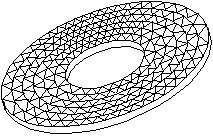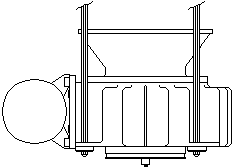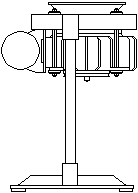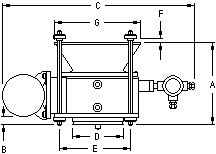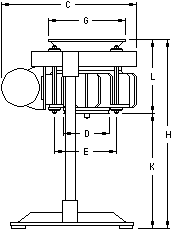Series F1 with Wet-Type Grids
General application: Series F1 units for dry processing are designed for separating fine ferromagnetic particles present as 1% (weight) or less of the material to be processed. Separators with wet-type grids are three to five times more effective than those equipped with vane-type grids for processing appropriate materials.
Maximum product temperature: All listed Series F1 models: 150°F (66°C); special Series F1 models with thermal insulation for higher product temperatures are available.
Field intensity, field gradient and energy gradient: The F1 Series is designed for maximum economy consistent with effective separation of fine ferromagnetic particles.Background magnetizing fields measured in the empty separating chamber (with pole pieces but without the matrix in place) are over 700 Oersteds in water-cooled models and over 500 Oe in air-cooled models. With the matrix in place the background field increases substantially. The background field induces a field several times more intense in the collecting elements. A high field gradient is provided at the collecting edges; the dimensions and orientation of the elements are essential to these high gradients.
Materials of construction: Metallic product-contact parts of standard units are cast gray iron, steel, galvanized steel and stainless steel, types 303, 304 and 430. Special units can be supplied with all metallic product contact parts made of stainless steel.
Matrices: Grids are fabricated by winding in spiral form two ribbons of type 430 stainless steel, one crimped to provide uniform openings and one flat. Nickel brazing provides rigidity. The matrix supplied for a particular application is composed of grids selected for ribbon dimensions and size of openings suitable for the material to be processed. Elastomer cushions are provided to prevent abrasion of metal parts.
Vibration: Models with wet-type grids have eccentric weight vibrators attached to their casings in a different way than models with vane-type grids. This mounting enhances material flow through the grid stack. Vibration can be adjusted for the specific material to be processed. Standard models have a cast iron hopper at the top and a hub at the bottom for attachment of a discharge sock. Installation in this manner permits the separator to vibrate freely in a system closed at the bottom. The hopper at the top may be replaced with a hub for connection of a feed sock for a completely enclosed system
Suspended models: The separator hangs on four aluminum rods with elastomer bushed connections at both ends to permit motion under vibration.
Floor models: With a floor stand and a frame from which the separator is suspended, the floor model can be moved to any location in the plant. Standard models have a feed hopper attached to the top, and a hub on the bottom.

